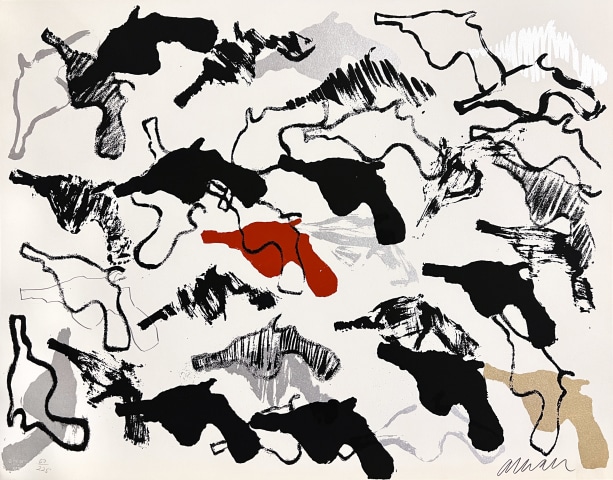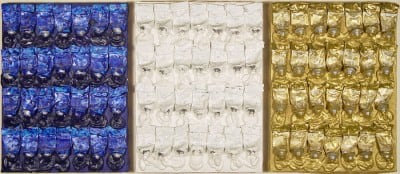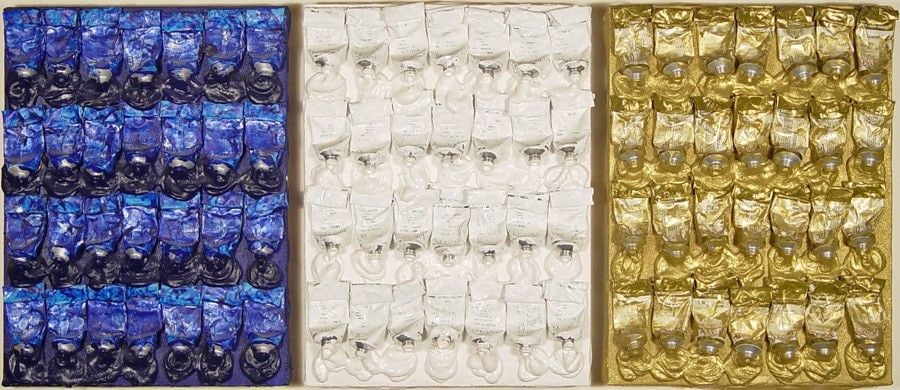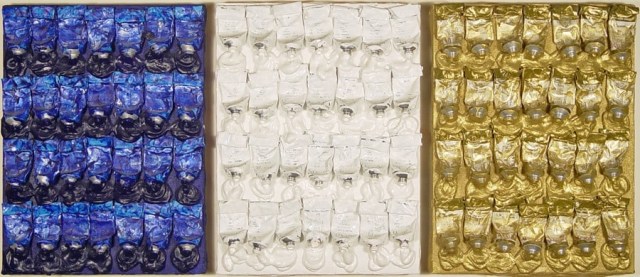
Arman

Monochrome Accumulations - Blue, White & Gold (triptych), circa 1986
Pierre Arman, whose birth name was Armand Fernandez, was born in Nice, France in 1928. His father, an antique dealer and weekend painter, had moved the family from Algeria to southern France. Best known for his ‘assemblages’ created from found objects, Arman divided his time between France and the United States.
His first exposure to painting was through his father, who gave him art lessons. In 1946, he began his painting study at the Ecole Nationale d’Art Decoratif in Nice, where he also earned degrees in mathematics and philosophy. There he met artists Claude Pascal and Yves Klein, and together they hitchhiked across Europe. He completed his studies in Nice in 1949, and went on to the Ecole du Louvre, studying oriental art and archaeology.
Some of his first works were in Abstract and Surrealist styles. At a 1954 exhibition in Paris, Arman was impressed with the works of Kurt Schwitters. This inspired him to begin working with stamp imprints known as ‘cachets’. Concurrently, he earned a living selling furniture, harpoon fishing, and other odd jobs. He first exhibited in London and Paris in 1956. A year later, he traveled to Turkey, Afghanistan, and Persia.
Featured works
Biography
The story of Arman’s name change is curious. He was an admirer of the works of Van Gogh, who omitted his first name in signing his paintings. Thus, Armand Fernandez decided to become simply Armand. Then in 1958, a Paris gallery, Galerie du Haut-Pave, mistakenly left off the ‘d’ of Armand. Upset at first, he later preferred to be known as Arman. In 1973, he changed his name to Armand Pierre Arman after becoming an U.S. citizen.
Arman began his Accumulations in 1959, where collections of like, everyday objects were crowded together in boxes, or vitrines. The objects were not arranged, expressing an element of chance in his work.
Along with Yves Klein, the two became founding members of the “Nouveau Realisme”, a group interested in creating different and new ways of thinking about real life and art. Yves Klein opened an exhibition entitled Le in 1958, consisting of empty gallery space to intrigue viewers about non-material things. Arman responded in 1960 with his exhibition of Le Plein, in which he filled the gallery with debris he collected from the streets of Paris. These non-utilized items, he believed, had their own distinctive worth, which should not be lost. In 1961, Arman visited New York City for the first time, and his work was shown as part of an exhibition called The Art of Assemblage at the Museum of Modern Art.
In 1962, after his friend Yves Klein passed away in Paris, Arman began to spend more time in New York City. His first museum retrospectives occurred in 1964 at the Walker Art Center, Minneapolis, and at the Stedelijk Museum in Amsterdam. From the 1970s through the 1990s, his art was primarily created for public participation and display. His largest work, Long Term Parking (1982), was a concrete tower of 60 cars, 65 feet high, standing in front of a suburban parking lot in Paris.
Arman has maintained studios in Paris and New York since 1973. He died in 2005.
Sources include:
Les Krantz, American Artists
Peter Falk, Who Was Who in American Art
American Sport Art Museum
ARTnews, Obituaries, December 2005, p. 92
Biography from the Archives of AskART

